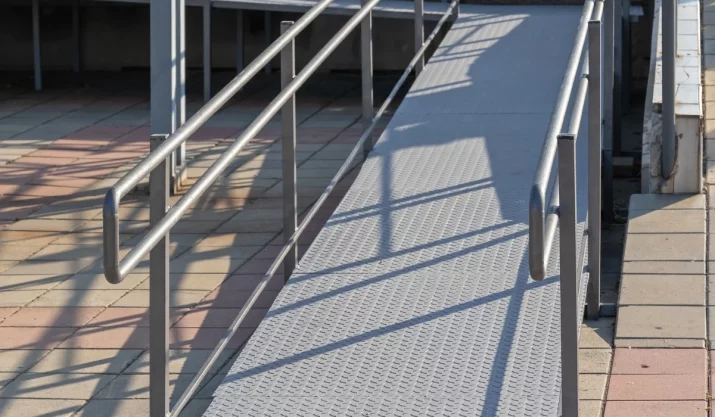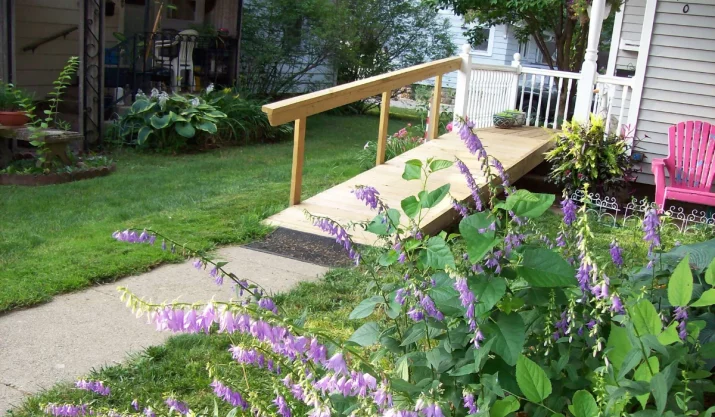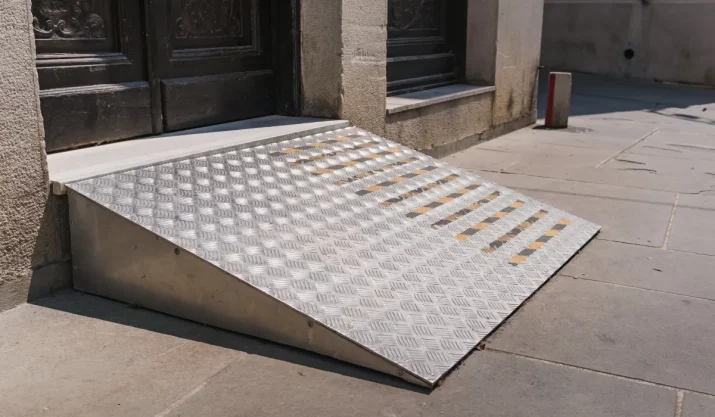What Material Is Best for Wheelchair Ramps?

Table of Contents
Choosing the right ramp material for a wheelchair ramp isn’t just about what’s available at the hardware store—it’s about ensuring safe, long-term wheelchair access for your home or property.
Whether you’re a homeowner, caregiver, or planning for a loved one, knowing which materials work best can help you make an informed decision that provides peace of mind and greater mobility device accessibility.
Let’s take a look at the different materials that are commonly used to build wheelchair ramps.
Key Takeaways
- Aluminum ramps are rust-resistant, easy to move, and safe for all weather with a slip-resistant, low-maintenance surface.
- Wood ramps look natural and cost less upfront, but need sealing and repairs often, especially in wet or humid areas.
- Concrete and steel ramps offer strong, stable access but need planning, installation help, and more maintenance over time.
- Picking the best ramp depends on your needs, and California Mobility can help with ADA-compliant ramps and installation.
Aluminum
Aluminum wheelchair ramps are one of the most popular choices for a reason. They’re lightweight yet durable, making them ideal for both modular ramps and portable ramps.
One of the biggest advantages is their built-in non-slip or slip-resistant surface, which can offer safer traction in both wet and dry conditions.
Because it doesn’t rust, it’s perfect for various weather conditions, including rainy or coastal climates. It’s also a low-maintenance material—no painting or sealing required. While it may cost a bit more upfront than wood, it usually pays off in reduced upkeep over time.
These ramps can also be disassembled and reused elsewhere, which is particularly helpful if you plan to relocate or anticipate temporary use.
Wood
Wood ramps are often favored for their natural look and ability to blend in with residential settings. But if you’re thinking about a wooden wheelchair ramp, there are a few things you’ll need to consider carefully.
Wood is subject to splintering, warping, and general wear and tear—especially in areas with a lot of moisture. These issues can compromise safety and may require regular maintenance, including sealing, staining, or replacing boards.
While pressure-treated lumber can extend the life of a wood ramp, you’ll still need to account for a proper non-slip surface and regular upkeep to prevent slips and falls.
It is often more affordable up front than aluminum or concrete, but the cost of maintenance adds up over time.
And don’t forget. Depending on where you live, you might need a building permit to install one, especially if it’s attached to your home.
Concrete
A concrete ramp is often seen as the most permanent and sturdy option.
If you’re looking for a type of ramp that won’t shift, warp, or wear down quickly, this is it. It’s highly durable, has excellent weight capacity, and can be customized with finishes that provide a non-slip surface.
However, concrete is best for long-term installations.
It’s not modular or easily moved, so you’ll want to be sure of the ramp’s placement and dimensions before construction begins. It’s also one of the more expensive options in terms of labor and materials.
Still, for homes needing a long-lasting access ramp—especially in areas with stable weather patterns and little risk of ground shifting—it can be a smart investment.
Steel
Steel ramps offer serious strength and durability, making them a solid option for wheelchair users who need a high weight capacity. Like aluminum, they can be built in modular sections, which makes them easier to install and adjust as needed.
However, steel is prone to corrosion if not treated properly. In humid or rainy climates, that can be a real concern. Galvanized or powder-coated finishes help reduce rust, but they don’t eliminate the need for regular maintenance.
One of its advantages is that it often comes with customizable handrails, making the ramp safer for those with limited mobility.
But due to its heavy weight and susceptibility to rust, it may not be ideal for portable or temporary setups.
How to Choose the Best Wheelchair Ramp Material for Your Home
When selecting the right wheelchair ramp material, it comes down to what works best for your unique situation. Here are a few questions to ask yourself:
- How long do I need the ramp—temporarily or permanently?
- What kind of weather conditions will the ramp be exposed to?
- Does the ramp need to be modular, portable, or customized to fit specific building codes?
- What is the weight capacity needed for different mobility devices?
- How much time and budget do I have for maintenance?
No matter the answers, choosing the right material is essential for maintaining safe and reliable home accessibility.
Ready for a Safer, More Accessible Home?
At California Mobility, we offer ADA-compliant aluminum wheelchair ramps and modular ramp systems designed with safety and comfort in mind. Whether you need a cost-effective accessibility solution or a custom ramp that blends into your home’s exterior, we’ll help you find the right fit.
Plus, our team handles everything from planning to wheelchair ramp installation, making the process easy for you and your family.
Want to talk with a mobility specialist? Give us a call to request a free consultation. Let’s make your home more accessible—for you or your loved ones.






